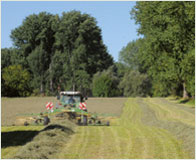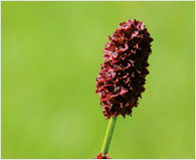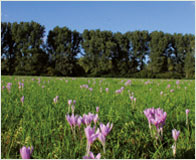- ι
- ι
- ι
- ι
- ι
- ι
- Visitor Information
- ι
Wetland Meadows - Colourful DiversitySlide show
The cutting edge
These hay meadows have been in cultivation for several centuries. The hay is cut twice a year, following a traditional cycle, and no fertilizer is used. This explains the astonishing biodiversity and wide range of wildflowers to be found among the oat grass. Regular flooding provides the meadows with nutrients.
These hay meadows have been in cultivation for several centuries. The hay is cut twice a year, following a traditional cycle, and no fertilizer is used. This explains the astonishing biodiversity and wide range of wildflowers to be found among the oat grass. Regular flooding provides the meadows with nutrients.


great burnet

autumn crocus
A floral soil map
The meadows around Haus Bürgel say it with flowers. These indicate clearly where the land is low-lying and where it is higher and drier: hawk's beard, autumn crocus, and goat's beard prefer drier soil, whereas the rare pepper saxifrage, meadowsweet, and purple loosestrife flourish on the damp low levels of land which are flooded more frequently and for longer periods. Lady's smock, burnet, and buttercups are more tolerant and populate the entire area.
The colourful season
The first pale pink dabs of colour appear in April when lady's smock begins to flower. Dandelion inaugurates the yellow season during which its smaller cousin hawk's beard also lifts its flowers skywards on branching scapes. Depending on the weather, the farmers begin to cut the hay starting at the end of May. At the height of summer the meadows are dotted with the blood-red heads of burnet. The flower season ends as it began, with pale pink, this time provided by the autumn crocus in late September.
A natural treasure
The wetland meadows around Haus Bürgel are among the most sensitive and valuable areas of the Urdenbacher Kämpe nature reserve. Traditional agricultural methods are used to protect the rare plants to be found on these meadows, which now belong to the Nordrhein-Westfalen-Stiftung, a state foundation supporting conservation, local history, and culture projects.
Watch your step
Delicate meadow plants don't like to be trodden or sat on. Please help us protect the plant life by keeping to the paths, and use the benches when you want a rest. All paths are clearly marked, not only by our man-made signage, but very often by broadleaf plantain, too, a robust plant also known as roadweed.
The meadows around Haus Bürgel say it with flowers. These indicate clearly where the land is low-lying and where it is higher and drier: hawk's beard, autumn crocus, and goat's beard prefer drier soil, whereas the rare pepper saxifrage, meadowsweet, and purple loosestrife flourish on the damp low levels of land which are flooded more frequently and for longer periods. Lady's smock, burnet, and buttercups are more tolerant and populate the entire area.
The colourful season
The first pale pink dabs of colour appear in April when lady's smock begins to flower. Dandelion inaugurates the yellow season during which its smaller cousin hawk's beard also lifts its flowers skywards on branching scapes. Depending on the weather, the farmers begin to cut the hay starting at the end of May. At the height of summer the meadows are dotted with the blood-red heads of burnet. The flower season ends as it began, with pale pink, this time provided by the autumn crocus in late September.
A natural treasure
The wetland meadows around Haus Bürgel are among the most sensitive and valuable areas of the Urdenbacher Kämpe nature reserve. Traditional agricultural methods are used to protect the rare plants to be found on these meadows, which now belong to the Nordrhein-Westfalen-Stiftung, a state foundation supporting conservation, local history, and culture projects.
Watch your step
Delicate meadow plants don't like to be trodden or sat on. Please help us protect the plant life by keeping to the paths, and use the benches when you want a rest. All paths are clearly marked, not only by our man-made signage, but very often by broadleaf plantain, too, a robust plant also known as roadweed.
Search:






